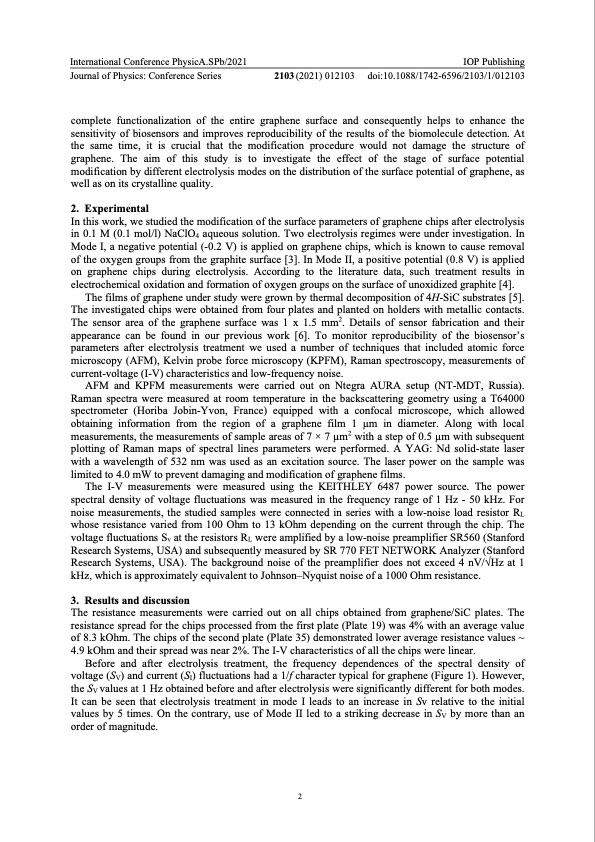PDF Publication Title:
Text from PDF Page: 003
International Conference PhysicA.SPb/2021 IOP Publishing Journal of Physics: Conference Series 2103 (2021) 012103 doi:10.1088/1742-6596/2103/1/012103 complete functionalization of the entire graphene surface and consequently helps to enhance the sensitivity of biosensors and improves reproducibility of the results of the biomolecule detection. At the same time, it is crucial that the modification procedure would not damage the structure of graphene. The aim of this study is to investigate the effect of the stage of surface potential modification by different electrolysis modes on the distribution of the surface potential of graphene, as well as on its crystalline quality. 2. Experimental In this work, we studied the modification of the surface parameters of graphene chips after electrolysis in 0.1 M (0.1 mol/l) NaClO4 aqueous solution. Two electrolysis regimes were under investigation. In Mode I, a negative potential (-0.2 V) is applied on graphene chips, which is known to cause removal of the охуgen groups from the graphite surface [3]. In Mode II, a positive potential (0.8 V) is applied on graphene chips during electrolysis. According to the literature data, such treatment results in electrochemical oxidation and formation of oxygen groups on the surface of unoxidized graphite [4]. The films of graphene under study were grown by thermal decomposition of 4H-SiC substrates [5]. The investigated chips were obtained from four plates and planted on holders with metallic contacts. The sensor area of the graphene surface was 1 x 1.5 mm2. Details of sensor fabrication and their appearance can be found in our previous work [6]. To monitor reproducibility of the biosensor’s parameters after electrolysis treatment we used a number of techniques that included atomic force microscopy (AFM), Kelvin probe force microscopy (KPFM), Raman spectroscopy, measurements of current-voltage (I-V) characteristics and low-frequency noise. AFM and KPFM measurements were carried out on Ntegra AURA setup (NT-MDT, Russia). Raman spectra were measured at room temperature in the backscattering geometry using a T64000 spectrometer (Horiba Jobin-Yvon, France) equipped with a confocal microscope, which allowed obtaining information from the region of a graphene film 1 μm in diameter. Along with local measurements, the measurements of sample areas of 7 × 7 μm2 with a step of 0.5 μm with subsequent plotting of Raman maps of spectral lines parameters were performed. A YAG: Nd solid-state laser with a wavelength of 532 nm was used as an excitation source. The laser power on the sample was limited to 4.0 mW to prevent damaging and modification of graphene films. The I-V measurements were measured using the KEITHLEY 6487 power source. The power spectral density of voltage fluctuations was measured in the frequency range of 1 Hz - 50 kHz. For noise measurements, the studied samples were connected in series with a low-noise load resistor RL whose resistance varied from 100 Ohm to 13 kOhm depending on the current through the chip. The voltage fluctuations Sv at the resistors RL were amplified by a low-noise preamplifier SR560 (Stanford Research Systems, USA) and subsequently measured by SR 770 FET NETWORK Analyzer (Stanford Research Systems, USA). The background noise of the preamplifier does not exceed 4 nV/√Hz at 1 kHz, which is approximately equivalent to Johnson–Nyquist noise of a 1000 Ohm resistance. 3. Results and discussion The resistance measurements were carried out on all chips obtained from graphene/SiC plates. The resistance spread for the chips processed from the first plate (Plate 19) was 4% with an average value of 8.3 kOhm. The chips of the second plate (Plate 35) demonstrated lower average resistance values ~ 4.9 kOhm and their spread was near 2%. The I-V characteristics of all the chips were linear. Before and after electrolysis treatment, the frequency dependences of the spectral density of voltage (SV) and current (SI) fluctuations had a 1/f character typical for graphene (Figure 1). However, the SV values at 1 Hz obtained before and after electrolysis were significantly different for both modes. It can be seen that electrolysis treatment in mode I leads to an increase in Sv relative to the initial values by 5 times. On the contrary, use of Mode II led to a striking decrease in SV by more than an order of magnitude. 2PDF Image | electrolysis-related modification of graphene films

PDF Search Title:
electrolysis-related modification of graphene filmsOriginal File Name Searched:
Eliseyev-2021-Phys-3A-2103-012103.pdfDIY PDF Search: Google It | Yahoo | Bing
Salgenx Redox Flow Battery Technology: Power up your energy storage game with Salgenx Salt Water Battery. With its advanced technology, the flow battery provides reliable, scalable, and sustainable energy storage for utility-scale projects. Upgrade to a Salgenx flow battery today and take control of your energy future.
CONTACT TEL: 608-238-6001 Email: greg@infinityturbine.com (Standard Web Page)